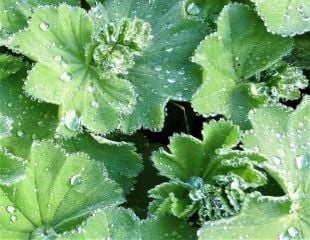
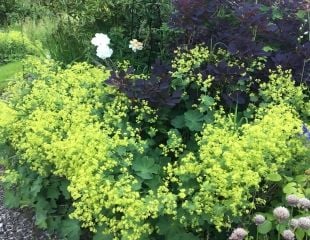
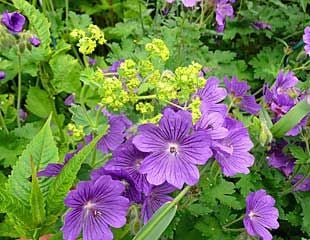
How to grow Alchemilla mollis common name Lady's mantle
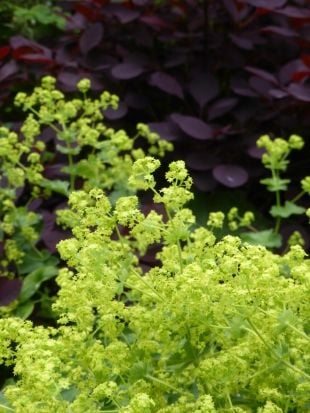
Alchemilla mollis, common name Lady's mantle, is an easy to grow herbaceous perennial, fully hardy which will grow in many conditions. It is another tough, grow anywhere plant.
The preferred growing conditions for Alchemilla are damp soil with some sun, but as a vigorous plant, it will grow in most conditions. These include semi shade, any aspect, exposed and sheltered spots, damp areas as long as they are not boggy. It is a useful plant to grow in awkward areas. This means you can plant Alchemilla pretty well anywhere in your garden and it will grow. It is a really useful garden plant, which looks good with a wide range of garden favourites, as shown in the various images. The only downside is its vigour and self seeding; it needs to be kept in check, see below.
The most common variety on sale and widely grown is Alchemilla mollis, a variety with the RHS award of garden merit, always a safe bet when choosing a plant.

When the flowers first emerge, they are a strong lime green colour which becomes a mass of tiny yellow flowers from early summer onwards. Alchemilla makes a mound of zingy lime green foliage, which is attractive, especially with raindrops as seen in the image above. The leaves are almost downy in appearance and hold the water well. This variety grows to around 60cm. In this image, the foliage is changing from lime green to yellow and it illustrates the frothy style of Alchemilla.
Alchemilla mollis look good with Allium cristophii . The lime green flowers contrast well with the purple Allium. It also serves to hide the base leaves of the Allium, which can look tatty even before the plant has flowered. Alchemilla around Alliums will cover the base leaves.
Alchemilla also looks good growing around the base of a Cotinus "Royal Purple", the strong lime green contrasts with the purple. You can also combine Alchemilla with the soft blue of Nepeta (Cat Mint) a delicate mix of blue with lime green/yellow and both flowering in June.

Here Alchemilla has been planted all along the base of this archway and adds a lovely lush feel. I have also seen Alchemilla planted to good effect growing at the base of a copper beech hedge and Alchemilla looks good along a path.
Alchemilla mollis is a simple plant. It is easy to grow, unfussy about its conditions and although a number are listed in the RHS Encyclopaedia of plants, you really only see A. mollis for sale.
As with many easy-to-grow plants, this one is vigorous and can be invasive in the garden. But it is easy to control.
Where it self seeds, did up the little plantlets before they get established.
Keep clumps of Alchemilla to size by checking its growth and dig out around the plant, removing excess growth. It is easy to control if regularly checked, so at the end or beginning of the growing year dig any unwanted growth to create space between the Alchemilla and surrounding plants. It has such lovely lime green flowers I would not hesitate to grow it; just keep it under control.


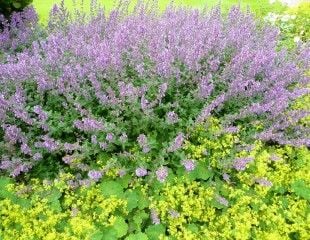
Cut back Alchemilla around July for a second flush
Cut right back for a second flush
Because Alchemilla comes into leaf early in the year, it can look tired by July, with brown spots and fawn areas marring the foliage. A simple solution is to take the shears to it; either a complete haircut or cut it partially in stages. Fresh foliage will be sprouting within a couple of weeks and look good for the rest of the growing season. It will not flower again, but it will produce fresh looking foliage.
The images below show how quickly Alchemilla grows back. Be bold. The first shows the Alchemilla in full bloom looking great, and then some weeks later when the foliage and flowers are looking tired and brown. I cut it back and within a short period, about 2.5-3 weeks, it had re grown some new fresh foliage, as in the third image.

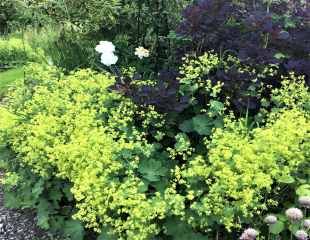
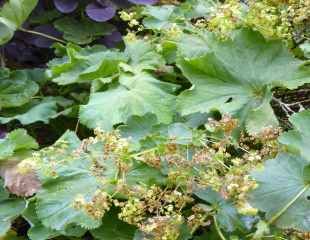
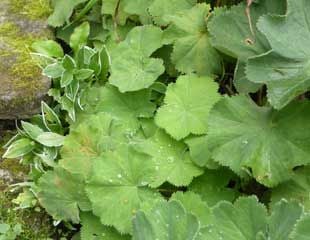
And At the end of the season check it and cut it back
Be brutal and cut it back
Towards the end of the growing season, when you can physically see the spread of Alchemilla, take the knife to it. The Alchemilla in the image was flowing all across to the bark path before I cut it back. It forms very tough clumps and I keep an old bread knife for tough perennials and hack it back to a neat line, keeping it in check.
This stops it taking over areas of the garden and neighbouring plants. Do not worry, it's so vigorous you will not kill it.
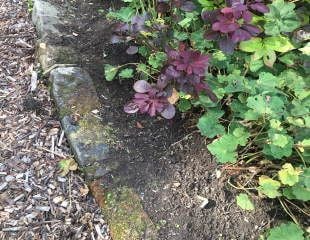

Alchemilla mollis are very easy to grow, too easy and can be invasive.
